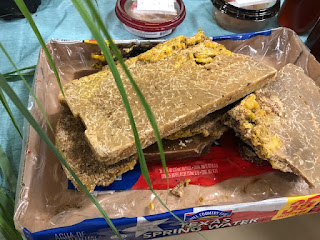Here recently I saw an ad for the upcoming 4th
Annual Honey Expo in Angleton. No ideal
what would be going on but, it sounded interesting. Today we went adventuring to Angleton.
You know, I have never been to Angleton before today.
“Angleton, founded in 1890, is the
county seat of Brazoria County and is considered part of the greater Houston–The
Woodlands–Sugar Land metropolitan area.
It was named for Mrs. George Angle, the wife of the general manager of
the Velasco Terminal Railway. (and nowhere did I find anything about her
– the wife with only her husband’s name given) Angleton was originally a
trade center for agriculture, devoted primarily to cotton, corn, truck farming,
and cattle, and later to rice and soybeans. A bitter rivalry emerged between Angleton
and the nearby town of Brazoria for the location of the county seat; Angleton
was chosen as the seat in 1896 and rechosen by county-wide election in 1913.”
The Honey Expo was held at the county fairgrounds – inside a
large building (with AC thank all the gods).
There were tables set up throughout with vendors selling honey and
various honey and bee products. There
were several programs scheduled about beekeeping and using honey
(unfortunately, it was so noisy, you couldn’t hear the speakers at all).
Here’s a couple Did You Know? bee things -
During chillier seasons, worker
bees can live for nine months. But in the summer, they rarely last longer than
six weeks—they literally work themselves to death.
When aging bees do jobs usually
reserved for younger members, their brain stops aging. In fact, their brain
ages in reverse.
Honeybees make out faces the same
way we do. They take parts—like eyebrows, lips, and ears—and cobble them
together to make out the whole face.
One of the first things I saw was this – a sort of “ant farm”
for bees. It’s a teaching tool for
children - - - of all ages – I thought it was very cool.
You could buy bee
boxes (hives) and swarm collectors.
Honey frames
Bee Pollen
Ok – everyone knows what pollen is – the male seed of
flowers. Honey bees collect the pollen.
And, here’s another odd fact - Bee
Pollen can only be synthesized by a worker honey bee. So bee pollen can’t be made
in a factory! And, with all the
superfood properties found in bee pollen, there are actually trace elements
found in in it that cannot even be identified through modern science. You know – magic bee stuff.
It’s full of vitamins,
minerals, amino acids, and protein. Interesting.
Beeswax
Mead
And, of course, Honey
And how, you ask,
do they extract the honey? A very chatty
young man gave us all a demonstration.
First you clean the frame of dead bees
Then you remove the
wax capping on each little honey hexagon.
Put the frame into an Extractor
And turn the handle.
Result – Honey!
And how cool is
that!
Just a few honey
facts –
Honey never spoils. It is
naturally acidic and low in moisture, making it an inhospitable environment for
bacteria.
A typical beehive can produce anywhere from
30 to 100 pounds of honey a year. To produce a single pound of honey, a colony
of bees must collect nectar from approximately 2 million flowers and fly over
55,000 miles.
Bees survive the winter by feeding on their honey.
Honey is medicinal and can be traced back to ancient Mesopotamia.
Because it is so inhospitable to bacteria, it was often used as a natural
bandage to protect cuts and burns from infection.
And finally, when performing a money spell or other ritual of
abundance, anoint your candle with honey to represent bounty, industriousness,
and sweetness. When cooking or baking
for those you love, include a spoonful of honey with a brief incantation for
lasting sweetness toward each other.
If we are going to
continue to eat, drink, and be merry in this world, we need bees.
20 Jul 2019














One more thing. If you want to know if you have bought real honey, take a flat bottomed bowl and put some water into it then add a teaspoon of honey. Swirl the water gently in the bowl. The honey will slide in the bowl and you will see what looks like a honeycomb pattern on the bottom of the bowl from real honey. Fake honey just swirls around and no pattern will form.
ReplyDeleteVery cool! Thanks.
DeleteVery interesting! As promised, I went out & bought honey yesterday. I just tried that trick that Leanna mentioned above & it works - I have the real deal. Cool!
ReplyDeleteBees are fascinating. My WI friends, who I am going to visit, kept hives for years.Sadly, I am allergic to bees and to honey.
ReplyDelete